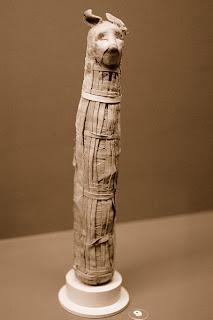In the second book of the Aten Sequence ‘Hall of the Crocodiles’ we are introduced to Prince Dhutmose’s cat Ta-miu. In the book Ta-miu is a very special royal talking cat who has a very important role to play in the unfolding of the story. We do know that the real, historical Prince Dhutmose did have a beloved pet called Ta-miu because her carved limestone coffin was discovered and is now in the Egyptian Museum in Cairo. What we don’t know is whether she could talk to her prince, but even if the Egyptian cats couldn’t talk or do magic they were revered by the Ancient Egyptians and they had an important cat goddess they called Bast.
 |
| Ancient Egyptian Bronze Cat |
Cats were regarded very highly by the Ancient Egyptians, so it is perhaps not too surprising that they worshipped a powerful cat goddess called Bast or Bastet. She is depicted as a cat or as a woman with the head of a feline. She was a daughter of the sun god Ra and her name means ‘warmth of the sun’. In the pharaonic period she was worshipped as a sun deity but, after their arrival, the Greeks associated her with one of their lunar goddesses Artemis and she became known as a moon goddess.
Like most Ancient Egyptian deities Bast had many attributes. In some guises she was an angry, vengeful goddess, one of her father Ra’s avenging deities sent to punish wrong doers and Egypt’s enemies. At other times she was a kind, protective goddess who would shower you with blessings if you gained her favour. She was also a goddess of fertility and love, with the cat being her sacred animal. It was considered to be a great sin to harm a cat, one certain way of bringing Bast’s wrath down on your head.
It is thought that cats were first domesticated in the Middle East in around 10,000 BC. They probably became so important to the Ancient Egyptians because they were so useful at killing vermin. They would have hunted and killed the rats, mice and venomous snakes that lurked in the granaries, houses and also in the fields surrounding the ancient settlements. They were also valued as domestic pets and there are tomb paintings that show these domesticated felines out hunting with their masters.
Bast was a very important, powerful goddess and her cult was spread the length of the Nile Valley, but the centre of her worship was at the city named after her in the Nile Delta. During pharaonic times the city was called Per-Bast or ‘House of Bast’ and it then became known as Bubastis. It reached the peak of its importance during the 22nd dynasty when Pharaoh Shoshenq I created it as his capital. The city remained the capital of Egypt for over 230 years until the Persian invasion led by Cambyses II in 525 BC.
What is left of the ancient remains of the city lies on the outskirts of the modern industrial city of Zagazig, some 80 kms north of Cairo. The great temple of Bast, which the historian Herodotus described as a building of great splendour and beauty, has been excavated. The building of this temple commenced in the 4th dynasty in the reign of the Pharaoh Khufu, who was the king who also constructed the Great Pyramid at Giza, and was extended and embellished by many successive pharaohs over the course of the next 1700 years. The temple of Bast was built from blocks of valuable red granite that had to be transported all the way from the distant quarries at Aswan.
The temple attracted many worshippers and Herodotus also recorded that a great annual festival was held to venerate the goddess. He noted that as many as 700,000 pilgrims would arrive in the town to celebrate, make votive offerings and join in the great procession. There was also a famous oracle of Bast located in the city.
 |
| Egyptian Cat Mummy |
One of the most common offerings made to gain favour and blessings from Bast was a mummified cat. Thousands upon thousands of these cat mummies have been discovered and there is a huge cat cemetery situated in Bubastis itself. This extensive cat necropolis was started in the Third Intermediate Period, and grew into a network of subterranean passages and tomb chambers made from mud brick some 200 metres north of the temple. The cat mummies were placed in niches and on shelves along the walls. Some of these cat mummies had been carefully wrapped in fine linen and placed in finely decorated coffins; others are much simpler, probably reflecting the wealth and status of the pilgrim. Because so many of these cat mummies have been discovered in Egypt, in the recent past many of them were ground up to use as fertiliser or burned for fuel.
Egyptian cat mummy image Wikimedia Commons Public Domain
Ancient Egyptian bronze cat image Wikimedia Commons Public Domain
I've always found it very interesting that cats were so important to Ancient Egyptians. Thanks for the information, Cynthia.
ReplyDeleteGlad that you found the article on the cat goddess Bast interesting Linda. Thanks for reading and leaving a comment
Delete